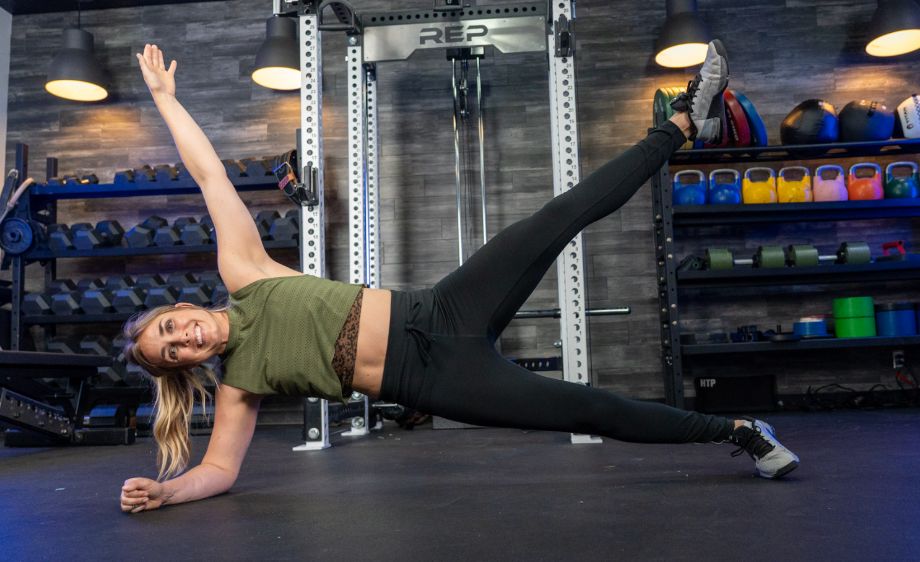We test and review fitness products based on an independent, multi-point methodology. If you use our links to purchase something, we may earn a commission. Read our disclosures.
Whether you want to improve your performance in other lifts, maintain a healthy spine, or feel confident about showing off your midsection, you must include side planks in your strength training program. This deceptively simple core movement packs a powerful punch, engaging multiple muscle groups to enhance your stability, balance, and posture.
RELATED: 14 Functional Core Exercises
A bodyweight exercise that fits seamlessly into any regimen, the side plank requires no equipment and offers many variations to keep your workouts fresh and challenging. As a certified personal trainer (CPT) who routinely incorporates plank exercises into my clients’ programs, I can attest to the transformative benefits of the side plank. In this guide, I’ll teach you how to perform the side plank safely and effectively, ensuring you get the most out of this valuable movement while avoiding common mistakes that can lead to injuries rather than well-defined obliques.
Get ready to take your abdominal training to the next level and experience the difference a strong, stable core can make in your fitness journey.
How To Do the Side Plank
The side plank is one of the best ab exercises because it’s simple and effective. It requires no equipment, making it perfect for at-home workouts or adding to your gym routine.
Here’s how to perform it correctly:
How to do it:
- Lie on your side with your legs extended and stacked on each other.
- Place your elbow directly under your shoulder, and your forearm perpendicular to your body.
- Engage your core and lift your hips off the ground until your body forms a straight line from your head to your feet. Your elbow and the side of your foot on your lower leg should support your weight.
- Hold this position for the desired time, keeping your body straight and your core engaged.
- Lower your hips back to the ground and switch sides to complete the exercise on the opposite side.
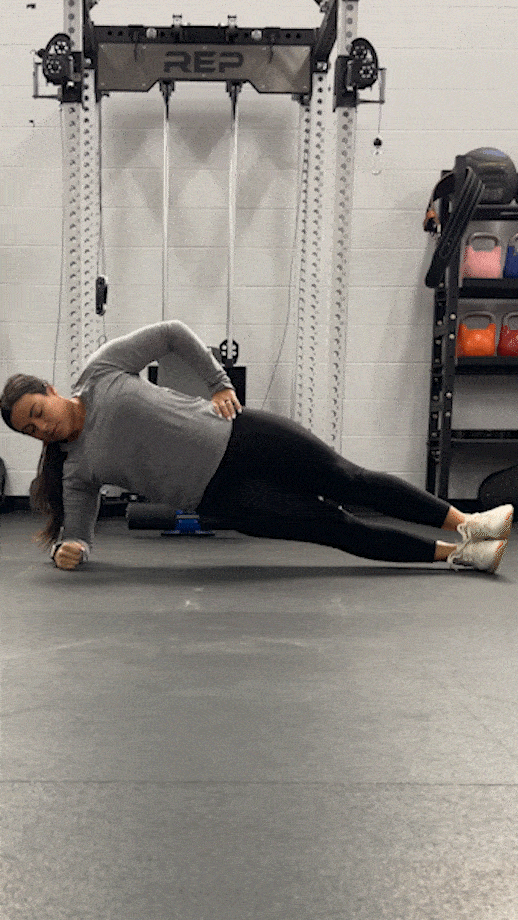
Modifications
- Dial it back: Perform the side plank with your legs bent and your bottom knee resting on the ground for additional support.
- Make it harder: Hold a dumbbell and extend your top arm toward the ceiling. This will challenge your shoulder strength and stability. Or, lift your top leg off your bottom leg to further activate your obliques, glutes, and hip adductors.
RELATED: Oblique Workouts
How To Do the Side Plank At Home
The side plank is an excellent exercise for at-home ab workouts. You only need a small amount of floor space and a comfortable surface like a yoga mat. Follow the same steps above to perform the side plank in the comfort of your own home.
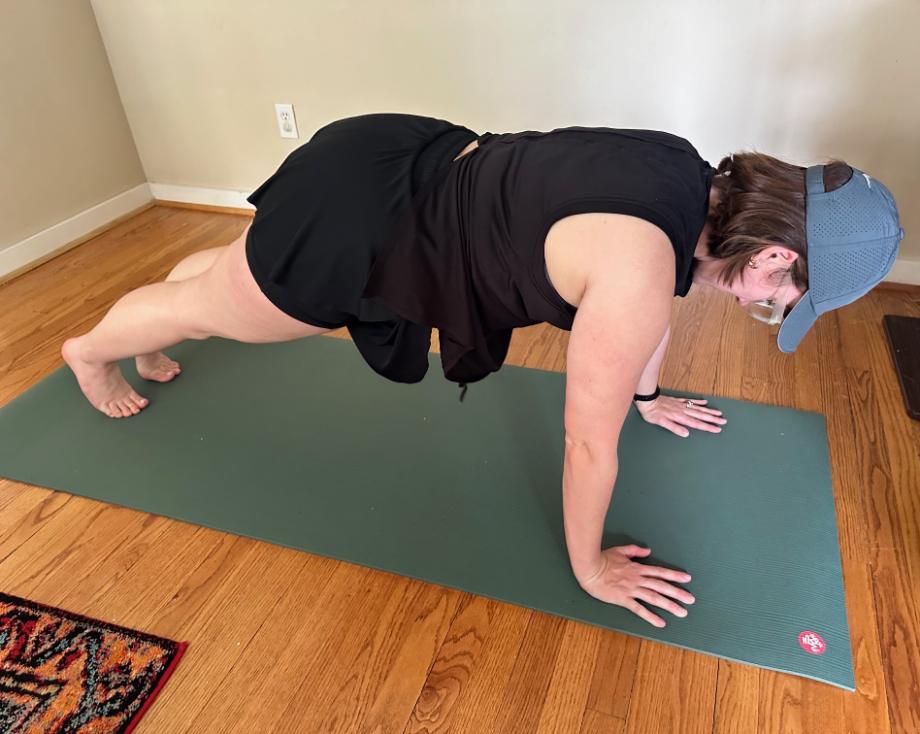
Side Plank Variations
- Side plank with hip dips: Lower your hips toward the ground and lift them back up while maintaining the side plank position. This variation targets your obliques even more intensely.
- Side plank with leg lift: Lift your top leg toward the ceiling while holding the side plank pose. This increases the demand on your core and adds a challenge for your balance.
- Side star plank: Extend your top arm and top leg toward the ceiling, forming a star shape with your body. This advanced variation requires significant core strength and stability.
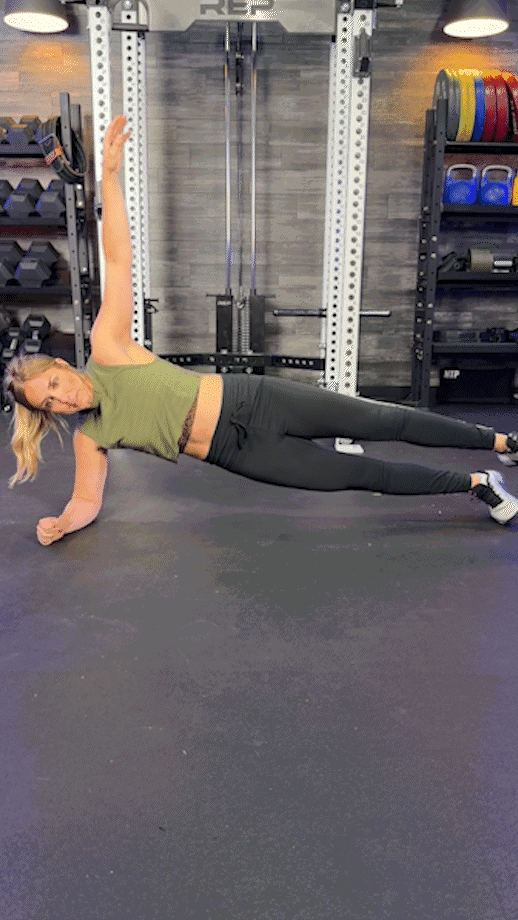
Side Plank Alternatives
If you’re looking for other effective ways to work your abdominal muscles and obliques, there are several great alternatives to the side plank. These exercises offer variety and can be tailored to different fitness levels, ensuring you can continue challenging your core and achieve balanced muscle development.
Forearm Plank
Why do it: The forearm plank is an excellent alternative that targets your entire core. Once you’ve mastered this basic bodyweight exercise, you can make it more challenging by balancing a weight plate on your back, increasing the time, or trying dynamic variations like toe-tap or forearm-to-hand planks.
How to do it:
- Lie face down and prop yourself up on your forearms and toes.
- Keep your body in a straight line from your head to heels.
- Engage your core, keep your back flat, and avoid sagging your hips.
- Hold this position for the desired amount of time.
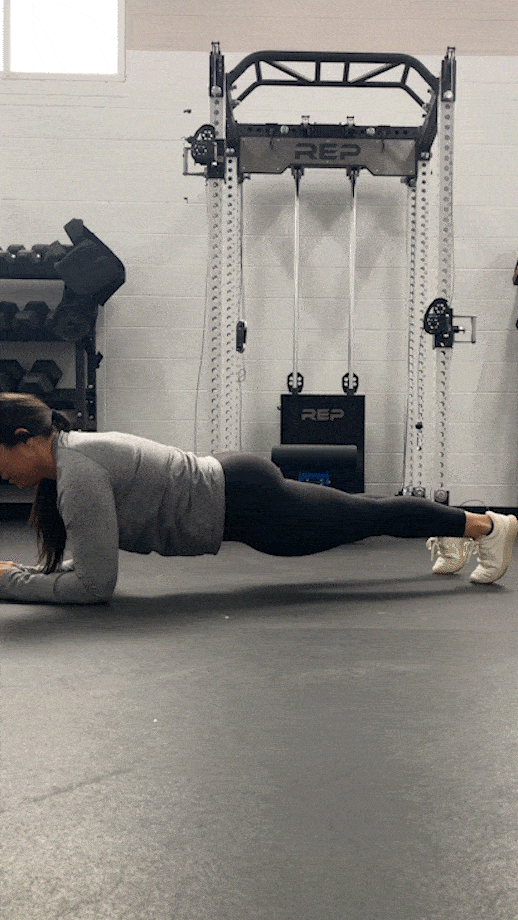
Bird Dog
Why do it: The bird dog exercise improves core stability and balance while engaging your back muscles, making it a great alternative to the side plank.
How to do it:
- Start on your hands and knees in a tabletop position.
- Extend your right arm straight out in front of you while extending your left leg behind you.
- Keep your back flat and engage your core to maintain balance.
- Return to the starting position and repeat with your left arm and right leg, alternating sides for the desired number of reps.
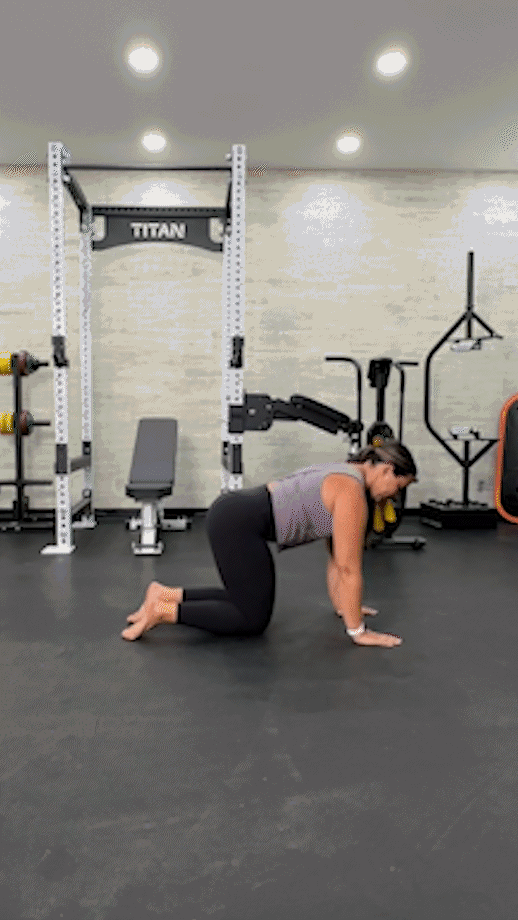
Dead Bug
Why do it: A beginner-friendly core exercise that helps improve coordination and control, dead bugs are similar to bird dogs in that you must extend your opposite arm and leg at the same time. However, you will lie on your back for this full-body exercise rather than doing so from a tabletop position.
How to do it:
- Lie on your back with your arms extended toward the ceiling and your knees bent at a 90-degree angle.
- Slowly lower your right arm and left leg toward the ground while pressing your lower back into the floor.
- Hold for 2 to 3 seconds, then return to the starting position.
- Repeat with the opposite arm and leg for the desired number of reps.
Trainer’s tip: Grab a pair of the best dumbbells and perform the exercise with added resistance to ramp up the difficulty.
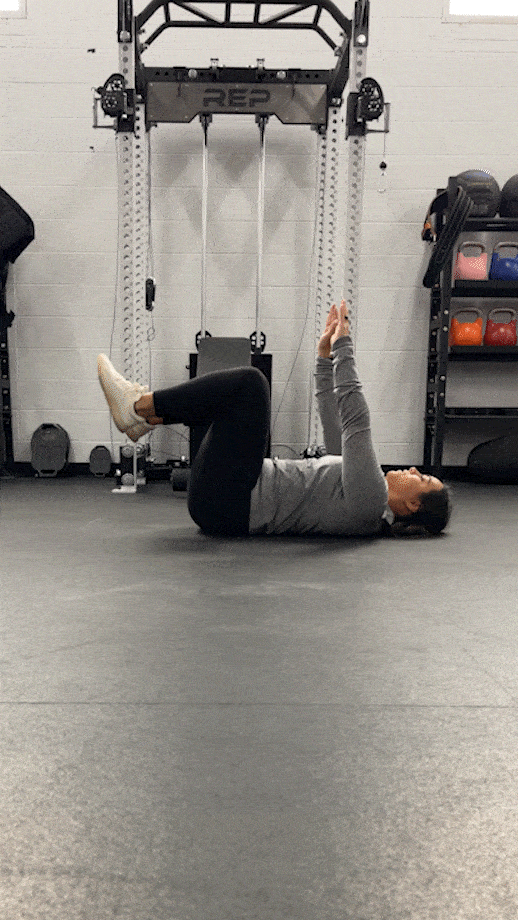
Russian Twist
Why do it: Russian twists effectively target your obliques and rotational muscles, providing a dynamic alternative to the side plank.
How to do it:
- Sit on the ground with your knees bent and feet flat, leaning back slightly to engage your core.
- Hold a kettlebell, dumbbell, or medicine ball with both hands in front of your chest.
- Twist your torso to the right, bringing the weight or ball beside your hip.
- Return to the center and twist to the left, continuing to alternate sides in a controlled manner.
- Repeat for the desired number of reps.
Trainer’s tip: Focus on slow, controlled movements to increase time under tension. Lift your feet off the ground to make the exercise even more challenging.
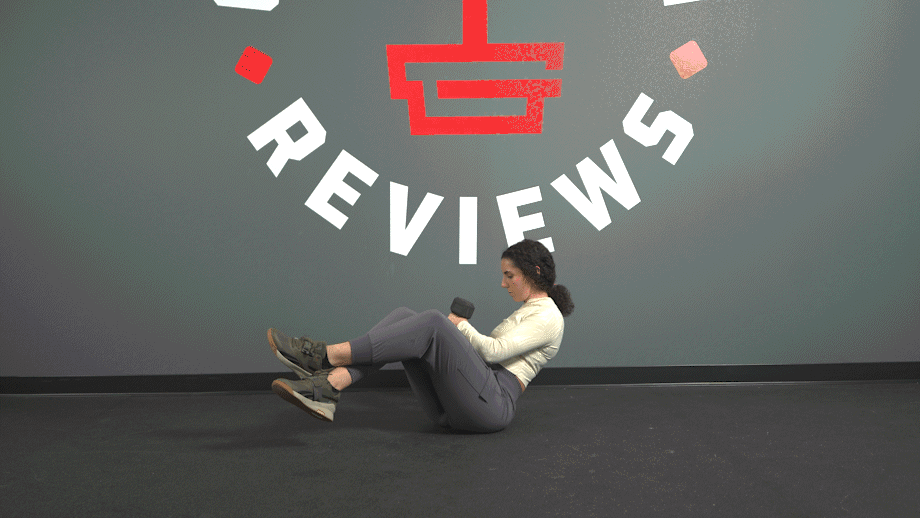
Benefits of the Side Plank
Incorporating this simple yet effective move into your core routine can strengthen your obliques, improve your posture, and reduce the risk of back pain. The side plank also fortifies your body’s foundation, which can help improve your performance in other lifts and daily activities.
Increases Your Core Strength
The side plank primarily engages the obliques, but it also works your entire core, including the transverse abdominis and rectus abdominis. This comprehensive engagement strengthens your core muscles, which are crucial for maintaining stability and balance in various movements.
A stronger core enhances your athletic performance and supports everyday activities, making you more efficient and less prone to injuries.
Helps Improve Your Stability
The side plank challenges your balance by requiring you to stabilize your body on one arm and the side of one foot. This engages not only your core but also your glutes, shoulders, and other stabilizing muscles.
Improved stability and balance from the side plank can enhance your performance in other exercises and sports, making you more agile and coordinated.
Helps Enhance Your Posture
The side plank can help improve your posture by strengthening your surrounding spine and pelvis muscles. A strong core supports the alignment of your spine, reducing the strain on your back and shoulders.
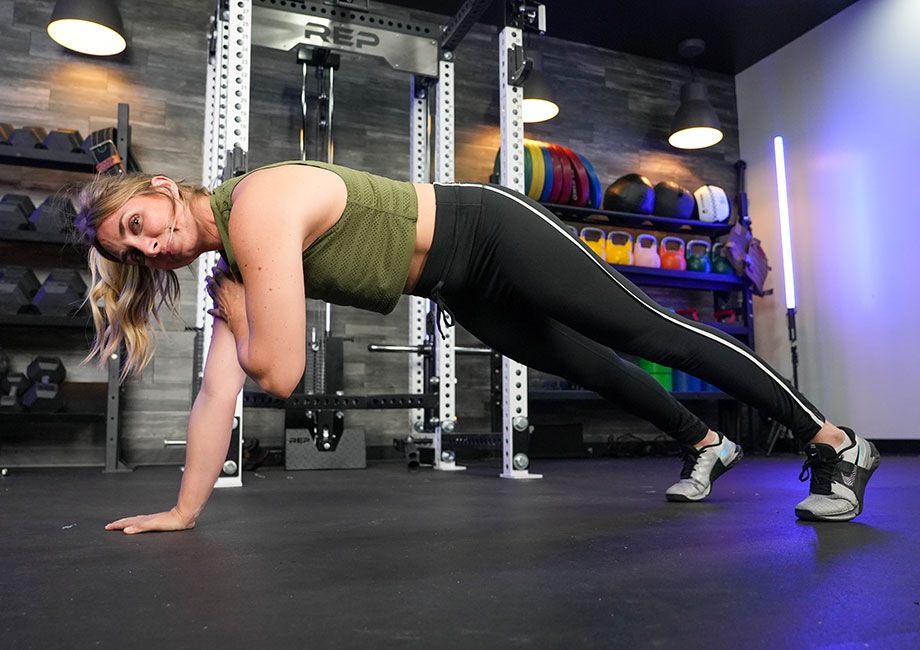
This can lead to better posture during your workouts and in daily life, helping you stand taller and move more gracefully.
May Help Reduce the Risk of Back Pain
A strong core protects your lower back from strain and injury. The side plank strengthens the deep core muscles, such as the transverse abdominis and quadratus lumborum, which support the spine and pelvis. By incorporating side planks into your routine, you can reduce the risk of back pain and improve your overall spinal health.
Common Side Plank Mistakes
Even though the side plank is a simple and effective exercise, it’s easy to make mistakes that can diminish its benefits and potentially lead to injury. By being aware of these common errors, you can ensure you perform the side plank correctly and get the most out of this core-strengthening move.
Not Maintaining Straight Posture
One of the most common mistakes in the side plank is failing to keep your body in a straight line from head to toe. Misalignment often occurs when you don’t correctly position your hips, shoulders, or head, leading to ineffective engagement of your abdominal muscles.
Ensuring your body remains in a straight line helps maximize the exercise’s benefits and prevents unnecessary strain on your lower back and neck.
Rotating Your Hips
Rotating your hips instead of keeping them stacked can shift the focus away from your obliques and compromise your spinal integrity. This rotation can lead to an uneven distribution of weight and place strain on your lower back.
Keep your hips square and facing forward to maintain proper form and target the intended muscle groups.
RELATED: 6 Rotation And 6 Anti-Rotation Exercises
Sagging Your Hips
Allowing your hips to sag toward the ground reduces the effectiveness of the side plank and can put undue stress on your lower back. This mistake often occurs due to weak core muscles or fatigue.
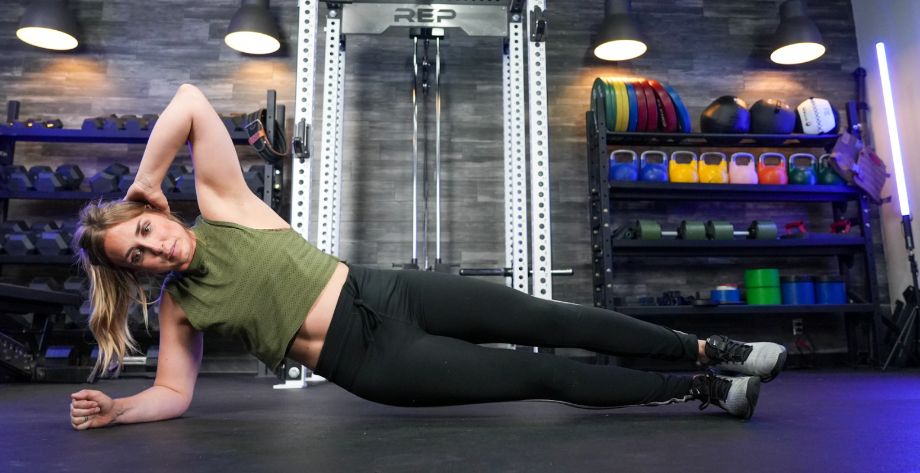
To correct this, focus on engaging your core and lifting your hips so your body forms a straight line, ensuring proper muscle activation and reducing the risk of injury. Squeeze your obliques to stay aligned.
Inadequate Shoulder Support
Failing to position the supporting shoulder directly over the elbow can result in shoulder discomfort and reduced stability. This misalignment can place excessive pressure on the shoulder joint.
Ensure your shoulder is directly above your elbow, and engage your shoulder muscles to provide a solid support base for the side plank.
RELATED: Best Shoulder Exercises
Straining Your Neck
Another common mistake is straining your neck by looking up or letting it drop out of alignment with your spine, which can lead to neck discomfort and detract from the core engagement.
To maintain a neutral and comfortable position, keep your head in line with your spine, gaze forward or slightly downward, and avoid any unnecessary tension in your neck.
Muscles Worked by the Side Plank
Understanding which muscles are involved in the side plank can help you engage them effectively and perform the exercise with proper form, ensuring you reap the maximum benefits for core strength and stability.
- Obliques: The side plank primarily targets the obliques, which are responsible for lateral flexion and rotation of the spine and help stabilize the body when in the side plank position.
- Transverse abdominis: This deep core muscle wraps around the torso and stabilizes the spine and pelvis during the side plank, helping to maintain proper alignment and stability.
- Quadratus lumborum: This deep muscle in the lower back helps stabilize the pelvis and spine, prevent hip sagging, and maintain a straight line from head to feet.
- Rectus abdominis: Known as the “six-pack” muscle, the rectus abdominis helps stabilize the torso and maintains the integrity of the core during the side plank.
- Gluteus medius and minimus: These gluteal muscles on the side of the hip help stabilize the pelvis and maintain proper hip alignment during the side plank.
- Gluteus maximus: The largest glute muscle helps support the lower body and maintain hip stability in the side plank position.
- Latissimus dorsi: This large back muscle helps stabilize the upper body and supports the shoulders during the side plank.
- Deltoids: The shoulder muscles, particularly the deltoid on the supporting arm, support your body’s weight in the side plank and help stabilize your scapulae (shoulder blades).
- Serratus anterior: This muscle helps stabilize the shoulder blade and supports the upper body during the side plank.
- Adductors: The inner thigh muscles assist in stabilizing the legs and maintaining proper alignment of the lower body during the side plank.
- Erector spinae: This group of muscles along the spine helps maintain proper spinal alignment and supports the back during the side plank.
RELATED: Treadmill Workouts For Targeting Abs
Side Plank: Final Thoughts
The side plank is a versatile and effective exercise that should be a staple in any ab workout routine. Beginners can use it to develop stronger obliques and a more stable core. Meanwhile, intermediate and advanced athletes can rely on variations like the starfish side plank to sculpt a strong, shredded midsection.
Ultimately, you can count on this core exercise to not only deliver aesthetic benefits but also help improve your posture and set you up for success in other lifts.
Side Plank: FAQs
What is a side plank?
A side plank is a core exercise that involves holding your body in a straight line while balancing on one forearm and the side of one foot.
What muscles are targeted when performing a side plank?
While the side plank primarily targets the obliques, it also engages the transverse abdominis, quadratus lumborum, glutes, shoulders, and other stabilizing muscles.
How long should a beginner hold a side plank?
A beginner should aim to hold the side plank for 20 to 30 seconds on each side, gradually increasing the duration as they build strength and endurance.
RELATED: Beginner Core Workout
What are the common mistakes to avoid while doing a side plank?
Common side plank mistakes include letting your hips sag, rotating them instead of keeping them stacked, and straining your neck by not keeping it aligned with your spine.
What is a side plank good for?
A side plank is excellent for building core strength, improving balance, enhancing posture, and increasing stability throughout your body.
Further reading

Whether you want to improve your performance in other lifts, maintain a healthy spine, or feel confident about showing off your midsection, you must include side planks in your strength training program. This deceptively simple core movement packs a powerful punch, engaging multiple muscle groups to enhance your stability, balance, and posture. RELATED: 14 Functional Core ExercisesA bodyweight exercise that fits seamlessly into any regimen, » Read more about: How To Do the Side Plank: Expert Tips to Strengthen Your Obliques and Build a Stable Core » Read more

Get started on a low-impact cardio machine with beginner elliptical workouts to get your heart rate up and muscles moving. Read more

Affordable doesn’t mean low quality. Our Nutricost Multivitamin Review offers expert insights to help you decide if this budget-friendly option suits you. Read more
![[Expert-Tested] Best Vegan Protein Powder (2025): No Whey, No Problem, According to Dietitians Cover Image](https://www.garagegymreviews.com/wp-content/uploads/transparent-labs-rice-and-pea-protein-2.jpg )
Looking for the best vegan protein powder for your training goals? We’ve got you covered. Read more

